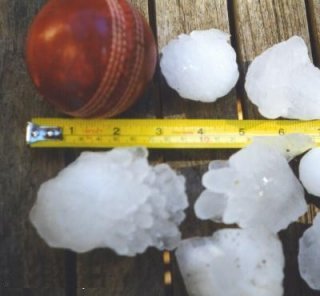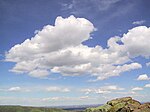Portal:Weather
The weather portal
Weather is the state of the atmosphere, describing for example the degree to which it is hot or cold, wet or dry, calm or stormy, clear or cloudy. On Earth, most weather phenomena occur in the lowest layer of the planet's atmosphere, the troposphere, just below the stratosphere. Weather refers to day-to-day temperature, precipitation, and other atmospheric conditions, whereas climate is the term for the averaging of atmospheric conditions over longer periods of time. When used without qualification, "weather" is generally understood to mean the weather of Earth.
Weather is driven by
Surface temperature differences in turn cause pressure differences. Higher altitudes are cooler than lower altitudes, as most atmospheric heating is due to contact with the Earth's surface while radiative losses to space are mostly constant.
Studying how the weather works on other planets has been helpful in understanding how weather works on Earth. A famous landmark in the Solar System, Jupiter's Great Red Spot, is an anticyclonic storm known to have existed for at least 300 years. However, the weather is not limited to planetary bodies. A star's corona is constantly being lost to space, creating what is essentially a very thin atmosphere throughout the Solar System. The movement of mass ejected from the Sun is known as the solar wind. (Full article...)
Selected article
The 1999 Sydney hailstorm was the costliest natural disaster in Australian history, causing extensive damage along the east coast of New South Wales. The storm developed south of Sydney on the afternoon of April 14, 1999 and struck the city's eastern suburbs, including the central business district, later that evening.
The storm dropped an estimated 500,000
The storm was classified as a

Previously selected articles:
Did you know (auto-generated) -

- ... that extreme event attribution estimates how much climate change causes weather events, such as the 2021 Western North America heat wave?
- ... that after Irish post office clerk Maureen Flavin Sweeney reported worsening weather conditions, Dwight D. Eisenhower agreed to postpone D-Day by 24 hours?
- ... that an attempted British-Norwegian attack on the German battleship Tirpitz was abandoned after two Chariot manned torpedoes were lost due to bad weather?
- ... that Eric Berger wrote about weather for the Houston Chronicleeven before he became a certified meteorologist?
- ... that weather whiplash is the phenomenon of rapid swings between extremes of weather conditions?
- ... that the weather forecast for HD 189733 b is "Westerly winds at 2000 m/s, with molten glass showers"?
Selected image

A
Recently selected pictures:
More did you know...
...that the Flying river is the name given to the transport of water vapor from the Amazon rainforest to southern Brazil?
...that hurricane shutters are required for all homes in Florida unless impact-resistant glass is used?
...that the
...that the SS Central America was sunk by a hurricane while carrying more than 30,000 pounds (13,600 kg) of gold, contributing to the Panic of 1857?
...that a hurricane force wind warning is issued by the United States National Weather Service for storms that are not tropical cyclones but are expected to produce hurricane-force winds (65 knots (75 mph; 120 km/h) or higher)?
...that the Automated Tropical Cyclone Forecasting System is a software package for tropical cyclone forecasting developed in 1988 that is still used today by meteorologists in various branches of the US Government?
Recent and ongoing weather
- Wikinews weather portal
- March 26, 2021: Tropical moisture ceases to cause severe floods in South East Australia
- February 19, 2021: Winter storms hammer Texas, fatalities reported
- December 28, 2021: Typhoon Phanfone strikes Philippines
- February 1, 2022: Deadly floods in Brazil after heavy rainfall
- April 15, 2022: South African floods kill at least 300 people
- Weather of 2024
- 2024 Atlantic hurricane season
- 2020–21 North American winter
- 2024 Pacific typhoon season
- Tornadoes of 2024
This week in weather history...
April 23
.
April 24
1908: One of the deadliest tornadoes in US history killed at least 143 people in Louisiana and Mississippi.
April 25
April 26
April 27
1980: Thai Airways Flight 231 stalled and crashed due to a downburst while flying through a thunderstorm on approach to Don Mueang International Airport, Bangkok, Thailand, killing 44 of 49 people on board.
April 28
2014: The second day of a multi-day tornado outbreak struck the Southeastern United States, bringing 50 tornadoes to 6 states that killed a total of 16 people.
April 29
1924: A tornado outbreak began which would kill at least 110 over the course of two days.
Selected biography
Previously selected biographies:
Related portals
Quality content
- List of North Carolina hurricanes (1900–1949)
- List of wettest tropical cyclones in the United States
Other candidates:
- Featured Article Review: 2005 Atlantic hurricane season (Discussion)
- Featured List Removal Candidate: List of storms in the 2005 Atlantic hurricane season (Discussion)
- Tropical Storm Kika (2008)
- Mid-October 2007 tornado outbreak
- Typhoon Meranti (2004)
- Surface weather observation
- Wildfire
- 1987 Atlantic hurricane season
- Cyclone Hondo
- Tropical Storm Olivia (2006)
- Effects of Hurricane Georges in Louisiana
- Typhoon Matsa
- Wet season
- Hurricane Cindy (2005)
Subcategories
WikiProjects
The scope of WikiProject Weather is to have a single location for all weather-related articles on Wikipedia.
WikiProject Severe weather is a similar project specific to articles about severe weather. Their talk page is located here.
WikiProject Tropical cyclones is a daughter project of WikiProject meteorology. The dozens of semi-active members and several full-time members focus on improving Wikipedia's coverage of tropical cyclones.
Wikipedia is a fully collaborative effort by volunteers. So if you see something you think you can improve,
Associated Wikimedia
The following Wikimedia Foundation sister projects provide more on this subject:
-
Commons
Free media repository -
Wikibooks
Free textbooks and manuals -
Wikidata
Free knowledge base -
Wikinews
Free-content news -
Wikiquote
Collection of quotations -
Wikisource
Free-content library -
Wikiversity
Free learning tools -
Wiktionary
Dictionary and thesaurus
Other Portals
What you can do
 |
Here are some tasks awaiting attention:
|
































